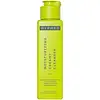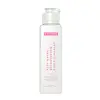What's inside
What's inside
 Key Ingredients
Key Ingredients

 Benefits
Benefits

 Concerns
Concerns

 Ingredients Side-by-side
Ingredients Side-by-side

Water
Skin ConditioningCocamidopropyl Betaine
CleansingCaprylyl Glucoside
CleansingGlycerin
HumectantSodium Methyl Cocoyl Taurate
CleansingAvena Sativa Kernel Extract
AbrasiveSodium Cocoyl Isethionate
CleansingSodium Polyglutamate Crosspolymer
Emulsion StabilisingGlycol Distearate
EmollientCeramide 1
Skin ConditioningCeramide 2
Skin ConditioningCeramide 3
Skin ConditioningCeramide 4
Skin ConditioningCeramide 6 Ii
Skin ConditioningLaminaria Digitata Extract
Skin ProtectingLecithin
EmollientSaccharide Isomerate
HumectantTrehalose
HumectantPEG-150 Distearate
EmulsifyingAcrylates Copolymer
Styrene/Acrylates Copolymer
Xanthan Gum
EmulsifyingSodium Lauroyl Lactylate
EmulsifyingCapryloyl Glycine
CleansingUndecylenoyl Glycine
CleansingCetyl-Pg Hydroxyethyl Palmitamide
Skin ConditioningCitric Acid
BufferingSodium Citrate
BufferingC12-15 Alkyl Benzoate
AntimicrobialTitanium Dioxide
Cosmetic ColorantStearic Acid
CleansingAluminum Hydroxide
EmollientPolyglyceryl-3 Diisostearate
EmulsifyingPhenoxyethanol
PreservativeBenzoic Acid
MaskingWater, Cocamidopropyl Betaine, Caprylyl Glucoside, Glycerin, Sodium Methyl Cocoyl Taurate, Avena Sativa Kernel Extract, Sodium Cocoyl Isethionate, Sodium Polyglutamate Crosspolymer, Glycol Distearate, Ceramide 1, Ceramide 2, Ceramide 3, Ceramide 4, Ceramide 6 Ii, Laminaria Digitata Extract, Lecithin, Saccharide Isomerate, Trehalose, PEG-150 Distearate, Acrylates Copolymer, Styrene/Acrylates Copolymer, Xanthan Gum, Sodium Lauroyl Lactylate, Capryloyl Glycine, Undecylenoyl Glycine, Cetyl-Pg Hydroxyethyl Palmitamide, Citric Acid, Sodium Citrate, C12-15 Alkyl Benzoate, Titanium Dioxide, Stearic Acid, Aluminum Hydroxide, Polyglyceryl-3 Diisostearate, Phenoxyethanol, Benzoic Acid
Water
Skin ConditioningDecyl Glucoside
CleansingSea Water Extract
Skin ConditioningCocamidopropyl Betaine
CleansingGlycerin
HumectantPropylene Glycol
HumectantCoco-Glucoside
CleansingSodium Ascorbyl Phosphate
AntioxidantGlycolic Acid
BufferingCurcuma Longa Callus Extract
Skin ProtectingCitrus Junos Fruit Extract
Skin ConditioningAloe Barbadensis Extract
Skin ConditioningSodium Lauroyl Sarcosinate
CleansingTriethanolamine
BufferingAcrylates/C10-30 Alkyl Acrylate Crosspolymer
Emulsion StabilisingXanthan Gum
EmulsifyingGlycol Stearate
EmollientCitric Acid
BufferingPhenoxyethanol
PreservativeEthylhexylglycerin
Skin ConditioningWater, Decyl Glucoside, Sea Water Extract, Cocamidopropyl Betaine, Glycerin, Propylene Glycol, Coco-Glucoside, Sodium Ascorbyl Phosphate, Glycolic Acid, Curcuma Longa Callus Extract, Citrus Junos Fruit Extract, Aloe Barbadensis Extract, Sodium Lauroyl Sarcosinate, Triethanolamine, Acrylates/C10-30 Alkyl Acrylate Crosspolymer, Xanthan Gum, Glycol Stearate, Citric Acid, Phenoxyethanol, Ethylhexylglycerin
Ingredients Explained
These ingredients are found in both products.
Ingredients higher up in an ingredient list are typically present in a larger amount.
Citric Acid is an alpha hydroxy acid (AHA) naturally found in citrus fruits like oranges, lemons, and limes.
Like other AHAs, citric acid can exfoliate skin by breaking down the bonds that hold dead skin cells together. This helps reveal smoother and brighter skin underneath.
However, this exfoliating effect only happens at high concentrations (20%) which can be hard to find in cosmetic products.
Due to this, citric acid is usually included in small amounts as a pH adjuster. This helps keep products slightly more acidic and compatible with skin's natural pH.
In skincare formulas, citric acid can:
While it can provide some skin benefits, research shows lactic acid and glycolic acid are generally more effective and less irritating exfoliants.
Most citric acid used in skincare today is made by fermenting sugars (usually from molasses). This synthetic version is identical to the natural citrus form but easier to stabilize and use in formulations.
Read more about some other popular AHA's here:
Learn more about Citric AcidCocamidopropyl Betaine is a fatty acid created by mixing similar compounds in coconut oil and dimethylaminopropylamine, a compound with two amino groups.
This ingredient is a surfactant and cleanser. It helps gather the dirt, pollutants, and other impurities in your skin to be washed away. It also helps thicken a product and make the texture more creamy.
Being created from coconut oil means Cocamidopropyl Betaine is hydrating for the skin.
While Cocamidopropyl Betaine was believed to be an allergen, a study from 2012 disproved this. It found two compounds in unpure Cocamidopropyl Betaine to be the irritants: aminoamide and 3-dimethylaminopropylamine. High-grade and pure Cocamidopropyl Betaine did not induce allergic reactions during this study.
Learn more about Cocamidopropyl BetaineGlycerin is already naturally found in your skin. It helps moisturize and protect your skin.
A study from 2016 found glycerin to be more effective as a humectant than AHAs and hyaluronic acid.
As a humectant, it helps the skin stay hydrated by pulling moisture to your skin. The low molecular weight of glycerin allows it to pull moisture into the deeper layers of your skin.
Hydrated skin improves your skin barrier; Your skin barrier helps protect against irritants and bacteria.
Glycerin has also been found to have antimicrobial and antiviral properties. Due to these properties, glycerin is often used in wound and burn treatments.
In cosmetics, glycerin is usually derived from plants such as soybean or palm. However, it can also be sourced from animals, such as tallow or animal fat.
This ingredient is organic, colorless, odorless, and non-toxic.
Glycerin is the name for this ingredient in American English. British English uses Glycerol/Glycerine.
Learn more about GlycerinPhenoxyethanol is a preservative that has germicide, antimicrobial, and aromatic properties. Studies show that phenoxyethanol can prevent microbial growth. By itself, it has a scent that is similar to that of a rose.
It's often used in formulations along with Caprylyl Glycol to preserve the shelf life of products.
Water. It's the most common cosmetic ingredient of all. You'll usually see it at the top of ingredient lists, meaning that it makes up the largest part of the product.
So why is it so popular? Water most often acts as a solvent - this means that it helps dissolve other ingredients into the formulation.
You'll also recognize water as that liquid we all need to stay alive. If you see this, drink a glass of water. Stay hydrated!
Learn more about WaterXanthan gum is used as a stabilizer and thickener within cosmetic products. It helps give products a sticky, thick feeling - preventing them from being too runny.
On the technical side of things, xanthan gum is a polysaccharide - a combination consisting of multiple sugar molecules bonded together.
Xanthan gum is a pretty common and great ingredient. It is a natural, non-toxic, non-irritating ingredient that is also commonly used in food products.
Learn more about Xanthan Gum